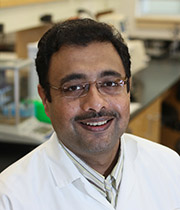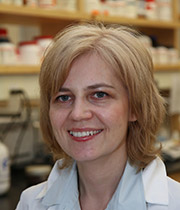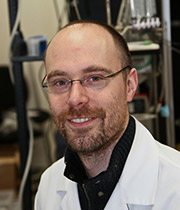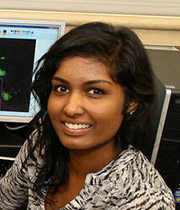Laboratory Staff
 Prior to joining the Motor Control Lab in 2005, Angel worked as a research assistant in the Pharmacokinetics and Metabolism Laboratory in the College of Pharmacy at Dalhousie University. As a foreign-trained veterinarian who has worked in a contract research organization abroad and is certified by the Canadian Association of Laboratory Animal Sciences, she is highly qualified to both manage the Motor Control Lab’s transgenic mouse colony and conduct animal research. Angel supports the research in this lab by performing immunohistochemistry, in situ hybridization and confocal imaging, while teaching basic laboratory procedures to students. At the same time, she oversees purchasing, materials control and management, grant and payroll administration, and other aspects of running a busy and productive basic science laboratory.
Prior to joining the Motor Control Lab in 2005, Angel worked as a research assistant in the Pharmacokinetics and Metabolism Laboratory in the College of Pharmacy at Dalhousie University. As a foreign-trained veterinarian who has worked in a contract research organization abroad and is certified by the Canadian Association of Laboratory Animal Sciences, she is highly qualified to both manage the Motor Control Lab’s transgenic mouse colony and conduct animal research. Angel supports the research in this lab by performing immunohistochemistry, in situ hybridization and confocal imaging, while teaching basic laboratory procedures to students. At the same time, she oversees purchasing, materials control and management, grant and payroll administration, and other aspects of running a busy and productive basic science laboratory.
Nadia Farbstein, research technician
 Nadia joined the Motor Control lab in 2004, following a number of years as a research assistant with the Forestry Genetics Group at Dalhousie University. She plays a crucial role in the daily progress of research in the Motor Control Lab, genotyping the mice that are required for experiments and maintaining the lab animal colony. She enjoys working with the many members of the lab and takes pride in the high-quality results she provides.
Nadia joined the Motor Control lab in 2004, following a number of years as a research assistant with the Forestry Genetics Group at Dalhousie University. She plays a crucial role in the daily progress of research in the Motor Control Lab, genotyping the mice that are required for experiments and maintaining the lab animal colony. She enjoys working with the many members of the lab and takes pride in the high-quality results she provides.
Postdoctoral fellows
 Dr. Tuan Bui joined Dr. Brownstone’s lab in 2006, after obtaining his PhD in physiology from Queen's University, where he performed computational studies of spinal motoneurons under the supervision of Dr. Ken Rose. He has been involved in numerous projects since joining the lab, including single cell modelling of motoneurons and network modelling of central pattern generators.
Dr. Tuan Bui joined Dr. Brownstone’s lab in 2006, after obtaining his PhD in physiology from Queen's University, where he performed computational studies of spinal motoneurons under the supervision of Dr. Ken Rose. He has been involved in numerous projects since joining the lab, including single cell modelling of motoneurons and network modelling of central pattern generators.
Tuan’s main project uses immunohistochemistry, electrophysiology, behavioural tests and other techniques to study dorsal spinal interneurons called dI3 interneurons. He has found that these interneurons play a crucial role in controlling hand function by conveying sensory information from the skin to the spinal cord. He and Dr. Brownstone have also found that dI3 interneurons provide an excitatory drive to the spinal locomotor network, which in turn modulates dI3 interneurons during locomotion.
 After finishing a PhD at the State University of New York-Buffalo, Dr. Pratip Mitra pursued postdoctoral studies at the University of Minnesota and the University of Illinois at Urbana-Champaign. He joined the Motor Control Laboratory at Dalhousie University in September 2007. Dr. Mitra’s primary experience and training is in cellular electrophysiological studies using the patch clamp technique. He has conducted neurophysiological research in the retina and is now working in the field of motor physiology, with a focus on the intrinsic electrophysiological properties of motoneurons and other spinal cord neurons. Using various types of transgenic mice at different stages of development, he is investigating the firing properties of neurons and how these are influenced by the presence or absence of different ion channels and a neuron’s role in its larger neuronal network. He enjoys conducting research in the Motor Control Lab, where he has access to an array of cutting-edge equipment and resources which, coupled with a congenial group of fellow scientists, provides a stimulating environment for research.
After finishing a PhD at the State University of New York-Buffalo, Dr. Pratip Mitra pursued postdoctoral studies at the University of Minnesota and the University of Illinois at Urbana-Champaign. He joined the Motor Control Laboratory at Dalhousie University in September 2007. Dr. Mitra’s primary experience and training is in cellular electrophysiological studies using the patch clamp technique. He has conducted neurophysiological research in the retina and is now working in the field of motor physiology, with a focus on the intrinsic electrophysiological properties of motoneurons and other spinal cord neurons. Using various types of transgenic mice at different stages of development, he is investigating the firing properties of neurons and how these are influenced by the presence or absence of different ion channels and a neuron’s role in its larger neuronal network. He enjoys conducting research in the Motor Control Lab, where he has access to an array of cutting-edge equipment and resources which, coupled with a congenial group of fellow scientists, provides a stimulating environment for research.
 Dr. Izabela Panek joined the Motor Control Lab in 2008, after working as a postdoc in the Department of Physiology & Biophysics at Dalhousie University. Prior to coming to Canada, Dr. Panek was a faculty member in the Department of Biophysics at Nicolaus Copernicus University in Torun, Poland, where she investigated various aspects of neuromodulation in invertebrates. She is now involved in spinal cord research with a focus on adult mammalian alpha and gamma motoneurons. Using patch clamp electrophysiology and genetically modified mice, she is revealing the fundamental characteristics of motoneurons and the properties that make the alphas so highly susceptible to degeneration in ALS (Lou Gehrig’s disease) – in contrast to the gammas, which are spared. At the same time, she has recently completed the Masters of Health Administration program at Dalhousie and hopes to find a niche where she can apply the skills developed through this program along with her neuroscience research skills.
Dr. Izabela Panek joined the Motor Control Lab in 2008, after working as a postdoc in the Department of Physiology & Biophysics at Dalhousie University. Prior to coming to Canada, Dr. Panek was a faculty member in the Department of Biophysics at Nicolaus Copernicus University in Torun, Poland, where she investigated various aspects of neuromodulation in invertebrates. She is now involved in spinal cord research with a focus on adult mammalian alpha and gamma motoneurons. Using patch clamp electrophysiology and genetically modified mice, she is revealing the fundamental characteristics of motoneurons and the properties that make the alphas so highly susceptible to degeneration in ALS (Lou Gehrig’s disease) – in contrast to the gammas, which are spared. At the same time, she has recently completed the Masters of Health Administration program at Dalhousie and hopes to find a niche where she can apply the skills developed through this program along with her neuroscience research skills.
Research associate
 Dr. Xiaolu Sun joined the Motor Control Lab in Sept 2012, after several years as an assistant adjunct professor at the University of California in San Diego, where she studied selective vulnerability and resistance to neurodegeneration. In her role at Dalhousie University, she studies brainstem neural circuits involved in motor control, using mouse transgenic technology and advanced imaging and electrophysiology techniques. These studies have important implications for developing new therapeutic strategies to treat spinal cord injury.
Dr. Xiaolu Sun joined the Motor Control Lab in Sept 2012, after several years as an assistant adjunct professor at the University of California in San Diego, where she studied selective vulnerability and resistance to neurodegeneration. In her role at Dalhousie University, she studies brainstem neural circuits involved in motor control, using mouse transgenic technology and advanced imaging and electrophysiology techniques. These studies have important implications for developing new therapeutic strategies to treat spinal cord injury.
Graduate students
Philippe Magown, PhD candidate
 Dr. Philippe Magown joined the neurosurgery residency program at Dalhousie University in 2005 after obtaining his medical degree from McGill University. Halfway through his residency, Dr. Magown embarked on a PhD in anatomy and neurobiology through the Department of Surgery’s Clinician Investigator Program. Working with supervisors Dr. Rob Brownstone and Dr. Vic Rafuse, he is investigating the use of embryonic stem cell-derived motoneurons in transplantation for motor function recovery. He is also interested in how embryonic motoneurons develop, as this may impact recovery outcomes. After he completes his PhD, Dr. Magown will return full time to his residency training. He plans to pursue research throughout his career, as a systematic means of addressing profound and longstanding clinical problems.
Dr. Philippe Magown joined the neurosurgery residency program at Dalhousie University in 2005 after obtaining his medical degree from McGill University. Halfway through his residency, Dr. Magown embarked on a PhD in anatomy and neurobiology through the Department of Surgery’s Clinician Investigator Program. Working with supervisors Dr. Rob Brownstone and Dr. Vic Rafuse, he is investigating the use of embryonic stem cell-derived motoneurons in transplantation for motor function recovery. He is also interested in how embryonic motoneurons develop, as this may impact recovery outcomes. After he completes his PhD, Dr. Magown will return full time to his residency training. He plans to pursue research throughout his career, as a systematic means of addressing profound and longstanding clinical problems.
 After graduating from Cairo University with a BSc in biophysics, Lina joined the Motor Control Lab in September 2012 to pursue a masters degree in neuroscience. Her research is focused on understanding the role of genetically identified interneurons in central pattern generators, the complex spinal cord circuits responsible for motion. By learning how these interneurons function and interact with other types of neurons in the spinal cord, Lina will contribute to a more comprehensive understanding of the mechanisms that control locomotion. She is learning many new techniques in the lab and enjoys the challenge of solving longstanding mysteries.
After graduating from Cairo University with a BSc in biophysics, Lina joined the Motor Control Lab in September 2012 to pursue a masters degree in neuroscience. Her research is focused on understanding the role of genetically identified interneurons in central pattern generators, the complex spinal cord circuits responsible for motion. By learning how these interneurons function and interact with other types of neurons in the spinal cord, Lina will contribute to a more comprehensive understanding of the mechanisms that control locomotion. She is learning many new techniques in the lab and enjoys the challenge of solving longstanding mysteries.
Honours student
Abi Thana, BSc (honours) student
 Abi Thana came to the Motor Control Lab in 2011, at the end of her first year of undergraduate sciences at Dalhousie University. Now in her third year, she is planning to complete a combined honours degree in neuroscience and biochemistry, and molecular biology. She hopes to take what she has learned in the lab to further explore the world of research, before applying to medical school.
Abi Thana came to the Motor Control Lab in 2011, at the end of her first year of undergraduate sciences at Dalhousie University. Now in her third year, she is planning to complete a combined honours degree in neuroscience and biochemistry, and molecular biology. She hopes to take what she has learned in the lab to further explore the world of research, before applying to medical school.

